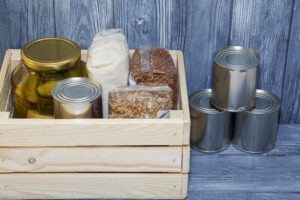The Importance of Long Term Food Storage
Long term food storage represents a critical aspect of emergency preparedness, and it is a practical habit for any household. It offers the assurance of having a reliable supply of nutritious food items in case of unforeseen circumstances, such as natural disasters, economic downturns, or global pandemics. Beyond these emergency scenarios, having a well-planned long-term food storage system can contribute to a balanced diet, reduce food waste, and save money by allowing bulk purchases and mitigating price inflation.
Understanding the Concept and Need for Long Term Food Storage
Understanding the concept of long-term food storage involves more than just buying and storing large quantities of food. It’s about strategically selecting and preserving food items that will maintain their nutritional value and remain safe to eat over an extended period. This can be achieved through various preservation techniques like canning, freezing, dehydrating, and vacuum sealing. Additionally, it’s crucial to rotate food supplies regularly to ensure they stay fresh and do not expire.
Types of Food for Long Term Storage
The types of food suitable for long-term storage vary in terms of shelf life, nutritional value, and preparation methods. Generally, foods that are low in moisture content and high in carbohydrates, proteins, and fats have a longer shelf life. Some examples include rice, beans, pasta, canned meats and vegetables, dried fruits and nuts, powdered milk, and grains like quinoa and oats. It’s also essential to have a balance of different food groups to maintain a well-rounded diet.
The need for long-term food storage is multifaceted. In emergency situations, having a stockpile of food ensures that you can feed yourself and your family until conditions improve. In more routine circumstances, it allows you to manage your food budget effectively, buying items in bulk when they’re cheaper or in season and using them as needed. Furthermore, well-planned long-term food storage can promote a balanced diet by ensuring a variety of nutritious foods are always available, regardless of seasonal constraints. It’s a practical and beneficial habit that can bring peace of mind and security to any household.
Examining the Relevance of Long Term Food Storage in Contemporary Society
In contemporary society, the relevance of long-term food storage is underscored by the increasing unpredictability of global events. Climate change has rendered weather patterns erratic, impacting agriculture and food production, while political uncertainties can unexpectedly disrupt supply chains. Furthermore, the recent COVID-19 pandemic highlighted potential vulnerabilities in just-in-time supply systems, which left many supermarket shelves bare. In these increasingly uncertain times, having a secure food storage system acts as a buffer, ensuring food security for households even when external conditions are unfavorable. Not only does it offer a practical way to ensure dietary variety, but it also fosters self-sufficiency and resilience, attributes that are increasingly important in today’s world.
Reasons for Long-Term Food Storage
One of the primary reasons for long-term food storage is disaster preparedness. Natural disasters, pandemics, or other unforeseen emergencies can disrupt food supply chains, making it difficult to procure necessities. Having a food reserve helps ensure that you and your family have access to nutrition during these challenging times.
Long-term food storage also provides economic benefits. When you buy food in bulk, the cost per unit generally decreases, making it a cost-effective practice. It can also reduce the frequency of grocery shopping trips, saving time and transportation costs.
Finally, long-term food storage encourages self-reliance. By planning and maintaining your food supply, you become less dependent on external factors like market availability or weather conditions. This also provides an opportunity to learn and practice food preservation techniques, enhancing your self-sufficiency skills.
How to Store Food for the Long Term
Proper Packaging Methods
The longevity of stored food largely depends on how it is packaged. Airtight containers like Mylar bags, vacuum-sealed bags, and food-grade buckets are excellent options. Oxygen absorbers can also be used within these containers to remove residual oxygen, thereby preserving the quality of the food and extending its shelf-life.
Optimal Storage Conditions for Long-term Food Storage
Regardless of the packaging method chosen, it’s crucial to store food in a dark, cool, and dry place. Temperature fluctuations and exposure to light can deteriorate food quality over time. Ideal storage temperatures are typically around 60 degrees Fahrenheit. It’s also essential to store food off the floor on shelving units to prevent damage from pests or potential flooding.
Utilization of Preservation Techniques
Employing food preservation techniques can significantly extend the life of food products. Canning is an effective method for preserving fruits, vegetables, and meats. Freezing, whilst space-consuming, is excellent for maintaining the nutritional value of a wide variety of foods, including produce, meats, and cooked meals. Dehydrating foods, like fruits or jerky, remove moisture, thus hindering bacterial growth and increasing shelf life. Each of these preservation methods requires specific equipment and knowledge, but with practice, can become an integral part of your long-term food storage strategy.
How to Get Started in Long Term Food Storage
Determining the Quantity of Food to Store
Before embarking on your long-term food storage journey, it’s crucial to accurately determine the amount of food your family will need. Here’s how to go about it:
Consideration of Family Size
The first step is to consider the number of people in your family. An adult will typically consume more food than a child, so it’s essential to factor in both the number and ages of individuals. Remember, more people means more food.
Calculating Consumption Rates
Next, calculate your family’s consumption rates. This involves understanding how much each family member eats on a daily basis and then multiplying that by the number of days you’re preparing for. This can be challenging, but considering the basic food groups and their recommended daily servings can provide a good starting point.
Accounting for Variety in Diet
Finally, it’s important to account for a variety in diet to ensure nutritional needs are met and food fatigue is avoided. Include a good balance of proteins, carbohydrates, and fats, and don’t forget fruits, vegetables, and dairy (or their long-term storage equivalents). Consider incorporating comfort foods and familiar favorites too, as these can boost morale in challenging times. Ensuring a diverse selection will make your long-term food storage more effective and enjoyable.
Beginning Long-Term Food Storage
If you are brand new to long-term food storage, don’t feel overwhelmed. Start with small achievable goal such as having three days of food and for each member of your family including pets. You will already be ahead of most people. Then work towards a two week supply of meals and water. Set up a system for your canned good so you are rotating the cans. Make most of this food be shelf stable items such as cans and packages and buy things your family already eats.
Expand this to a months supply of food and water for each family member and pet. Just pick up a few things extra each time you go to the store. just keep rotating your cans as you prepare meals. Don’t underestimate the need for water storage. At minimum store one gallon per day for each person and pet. If you live in a desert environment store more.
When your ready to up your food storage consider adding in staples like beans and rice that have very long storage times. LDS online food store has the cheapest prices for this type of thing and very low shipping.
When to Use Stored Food
Using stored food shouldn’t only be reserved for emergencies. It’s advisable to incorporate these items into your regular meal rotation, which not only allows you to get used to the taste but also ensures the food doesn’t go to waste.
Rotation Schedules for Long-Term Food Storage
Establishing a rotation schedule is crucial to maintaining freshness in your long-term food storage. The method, often referred to as “first in, first out,” involves organizing your food storage in such a way that the oldest items are used first. Regularly updating your inventory and clearly marking purchase dates can aid in this process.
Understanding Expiration Dates
Expiration dates are often misunderstood. They usually indicate the manufacturer’s estimate of when the food will no longer be at peak quality, rather than when it becomes unsafe to eat. However, it’s important to inspect food for signs of spoilage before consumption, regardless of the printed expiration date.
Incorporating Stored Food into Everyday Meals
Integrating stored food into your regular meals can be a creative process. Dehydrated fruits can be added to cereals, canned vegetables to stews, and powdered milk can be used in baking. This practice not only ensures you’re rotating your stock but also helps make the transition to stored food in a crisis situation less abrupt.
How to Afford Long Term Food Storage
Long-term food storage may initially seem like a costly endeavor. However, with careful planning and strategic purchasing, it can be affordable. Begin by setting a budget that is realistic for your income and expenses. Next, instead of buying everything at once, consider purchasing a few items with each shopping trip to spread out the cost. Take advantage of sales and bulk purchase discounts when available. Another cost-saving strategy is to preserve local, in-season produce by canning, dehydrating, or freezing. Additionally, investing in high-quality, durable containers for storage can save money in the long run by keeping food fresh and free of pests. Remember, the goal is not just to fill your pantry, but to build a sustainable, diverse stock of food that meets your dietary needs.
Conclusion
In conclusion, preparing and maintaining long-term food storage can provide a sense of security and peace of mind in uncertain times. By following these guidelines for proper storage, rotation, and utilization of stored food, you can ensure that your family will have nutritious meals during a crisis or emergency. Remember to regularly check expiration dates, inspect for signs of spoilage, and incorporate stored food into your regular meal planning to maintain a healthy and well-balanced diet. With careful planning and smart purchasing, long-term food storage can be both affordable and beneficial for you and your loved ones. Start now and take small steps towards building a sustainable food supply for the future. Always be prepared! So, start today by taking stock of what you already have on hand and creating a plan for what you still need. Don’t forget to rotate your stock and incorporate it into your regular meal planning to ensure freshness and avoid waste. With a little bit of effort, you can build a well-rounded food storage supply that will provide peace of mind and nourishment for you and your family in any situation. Remember, every step toward preparedness is a step toward security and self-sufficiency. Stay safe and stay prepared! So, continue to educate yourself on emergency preparedness and take steps to build your stockpile of food sustainably. Remember, the key is to have a diverse supply of nutritious foods that meet your dietary needs and can sustain you for an extended period.
For more on food preservation click here.


